
August 22, 2010
 25 Emblematic Comics Of The ‘70s—A Lengthy First Draft In Partnership With CR’s Readers
25 Emblematic Comics Of The ‘70s—A Lengthy First Draft In Partnership With CR’s Readers
 By Tom Spurgeon
By Tom Spurgeon
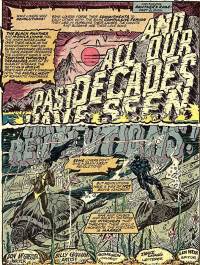
A discussion of the 1970s Marvel superhero saga "Panther's Rage" between Tucker Stone and David Brothers launched ten days ago led me to ask the
CR readership in this space last Sunday about emblematic comics of the 1970s, works that are deeply and wholly of that time -- not just as a novelty items or fannish milestones but in terms of how we understand the form. This is the list that was developed from their suggestions.
It's not a list of the best comics of that decade or even the most influential. There are omissions that would likely drive a number of comics fans nuts. I did include one novelty comic book on the list, but I did so because I thought it was the one that did the best job of all those books of telling a memorable story. Otherwise, for the sake of this list there's a line in the sand for a lot of those works that ends up being pretty hard to cross. For me, comics like
Star Wars #1 or the Death of Gwen Stacy in
Amazing Spider-Man have come to mean more as ideas or concepts or covers or editorial moves or shared fan history than they represent memorable contributions to the form.
A lot of people suggested a lot of superhero comics. Heck, a lot of you suggested nothing but superhero comics. I only ended up with a few on the list. I've read every comic suggested. I nearly always discounted superhero comics that I've read that I couldn't remember now, that haven't stuck with me as a reader. I like a quality run of adventure comics as much of the next guy, and it was a mainstream comics decade, but I don't think that automatically makes many of those runs noteworthy. A comic that may seem special from the context of works almost exactly like it may simply seem less so if all genres and all different kinds of books are included in that examination. In the end, I just had to make some calls, and I'll include two or three of the more compelling cases at the end of the list that didn't make it in.
So to answer my own question, were I a future librarian approached by a sequential arts student with a term paper to do on the 1970s, I would point to the following pile of publications and tell them "This is what comics looked like then; this is what comics were like." -- Tom Spurgeon
*****
 * A Contract With God, Will Eisner, A Stand-Alone Book Publication Comprised Of Four Stories
* A Contract With God, Will Eisner, A Stand-Alone Book Publication Comprised Of Four Stories
Will Eisner created the graphic novel the same way Christopher Columbus discovered America -- by which I mean in no way except one that granted commercial continuity between what he did and everything yet to come. That's more than enough. The sentimentality of the four short stories presented -- all of which take place in a special world of Eisner's creation where it
rains with overwrought emotion -- is sometimes hard for a reader not accustomed to it to swallow. There's no denying the urgency and seriousness with which the stories are presented, though, an in making the intent of the author a significant part of what defined the graphic novel, Eisner did the art form a massive favor.
*****
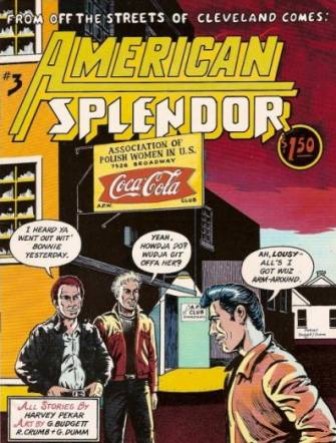 * American Splendor #1-4, Harvey Pekar and Various, Issues Of A Comic Book Series Self-Published By Pekar
* American Splendor #1-4, Harvey Pekar and Various, Issues Of A Comic Book Series Self-Published By Pekar
American Splendor would continue in one form or another for three full decades after the 1976-1980 period, and you might be able to argue that Pekar went most of that first period without even basic recognition from a natural, initial audience that would come to him slowly in the 1980s. Still there's no denying the quality of the best pieces in the very first few issues, particularly those with Robert Crumb, and the autobiographical elements made these comics about the '70s in a very revealing way. During a period in comics history soaked in the fantastic and almost wholly given over to characters with corporate sponsorship, Pekar planted a flag deep in a territory some fans didn't even know existed.
*****
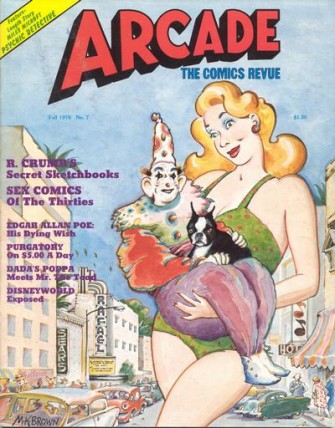 * Arcade, Various, An Anthology Series From The Print Mint
* Arcade, Various, An Anthology Series From The Print Mint
A repositioning of the anthology away from a market-driven need or even an auteur editor's efforts into more of a group statement by a bunch of artists with a shared sensibility, something every major book of its type would evince at least in part from this moment. Plus there are any number of fine artists here; the book managed to get all of its generation's lifers into one place.
*****
 * The Early Chapters Of Barefoot Gen, Keiji Nakazawa, A Serialized Comic From I Believe More Than One Publisher
* The Early Chapters Of Barefoot Gen, Keiji Nakazawa, A Serialized Comic From I Believe More Than One Publisher
One of the first manga to penetrate into the consciousness of international audiences, the nature of the direct, cartoon-reminiscent art style took some people by surprise, and the constant negotiation of styles that would dominate the early years of Eastern comics in the West had begun. There's no denying the kick in the stomach that was the story, in any style or language, perhaps best realized in a scene when our protagonist carries his family members remains from one place to another in a bucket.
*****
 * Cat, B. Kliban, A Stand-Alone Book From Workman
* Cat, B. Kliban, A Stand-Alone Book From Workman
It's baffling that one fine Tim Kreider essay is all the laudatory writing from modern sources that seems to exist on the great B. Kliban. Kliban was the funniest cartoonist of the decade, edging out Shelton and Trudeau. His cartooning was rich and beautiful. He also put into constant play a kind of muffled rage at the world's absurdities that punches you right in the heart 40 years later. He was equally great encountered one cartoon amongst many or in his powerful book collections. Those books were absurdly popular outside the realm of hardcore comics fans, and influenced everyone from a range of political cartoonists to some of the best newspaper strip cartoonists 1980s-on.
*****
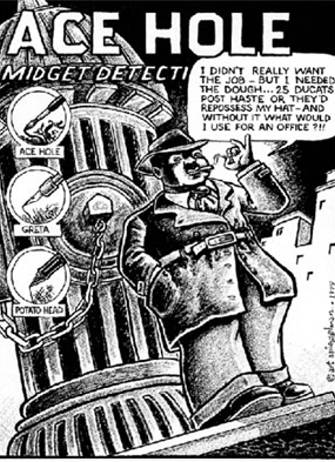 * Breakdowns, Art Spiegelman, A Collection Of Comics From Belier Press
* Breakdowns, Art Spiegelman, A Collection Of Comics From Belier Press
Art Spiegelman's early career effort has become synonymous with formal play, but squint just a tiny bit and you can easily see
Breakdowns as the first of the one-man anthologies that came to challenge the one-cartoonist/one-series model by which the North American comics reading world began to make room for something other than licensed character kicking at or joking with one another.
*****
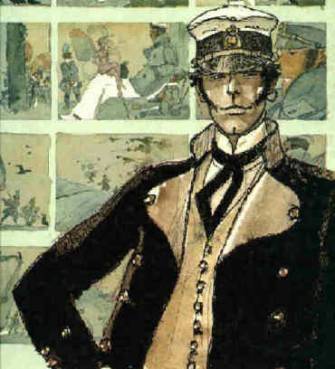 * Corto Maltese, Hugo Pratt, A Variety Of Comics Featuring The Same Character And Setting
Corto Maltese
* Corto Maltese, Hugo Pratt, A Variety Of Comics Featuring The Same Character And Setting
Corto Maltese began in the 1960s and stretched into the 1980s, but Hugo Pratt's great achievement seemed most at home in the 1970s when even the republication of earlier work could win major awards. Pratt built the series the old-fashioned way, through a variety of different-sized stories drawing out different aspects of the lead character and different permutations of his own cartooning skill. It was the decade's fondest, finest look back.
*****
 * Doonesbury, Garry Trudeau, A Newspaper Comic Strip And Collection Series
* Doonesbury, Garry Trudeau, A Newspaper Comic Strip And Collection Series
It's hard to remember this now, but the popularity of
Doonesbury in its early years, when its cancellation could lead to hundreds of upset people actively mad at the local newspaper, will likely never be seen again. Trudeau's great strength in his later years was the size and versatility of his cast. Here he's still building the repertory company, but nearly half the core players are inspired and his ongoing, subtle suggestion that everyone is connected to every issue if only by seeing the grotesqueries involved on a television screen got the audience involved as well.
*****
 * Elfquest #1-5, Wendy and Richard Pini, A Self-Published Comic Book Series
* Elfquest #1-5, Wendy and Richard Pini, A Self-Published Comic Book Series
Only five issues of the self-published pioneer came out in the 1970s, but it's still the property's best story, or at least is most raw, and that people responded to those elements so strongly is what I think makes it an emblematic comic of that time. The story of a people driven from one home to another is stuffed with sex and death and second-guessing and loads of regret, none of which really smooth out as gracefully as Wendy Pini's art would have you belief. Pini examines sexual desire as it relates to personal merit and the ability to choose one's own mate, which if not a comfortable line of inquiry -- there are some outright creepy elements involved, especially when you learn more about the elves later on in the series -- it is at least all
Elfquest's at that point in comics history, and the kind of personalized take on genre that only became possible for comics in that decade.
*****
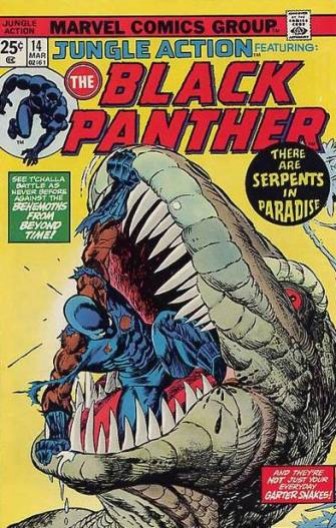 * "Panther's Rage" In Jungle Action, Don MacGregor and Various, Storyline In A Marvel Comics Series
* "Panther's Rage" In Jungle Action, Don MacGregor and Various, Storyline In A Marvel Comics Series
I said all I wanted to say about this one last time out, but it's essentially the kind of character resuscitation through the prism of comic book realism that provides a model for a significant portion of comics done today.
*****
 * Heavy Metal, Various, An Anthology Comics Magazine
* Heavy Metal, Various, An Anthology Comics Magazine
I'll defer to Joe "Jog" McCulloch here: "Not to be confused with Star*Reach before it or Sabre after -- i.e., comics that put themselves out as bridging the gap between underground freedom of aesthetics and mainsteam popular appeal (or, whatever was left of it by that time). No, Heavy Metal effectively slashed out a third path via its ad hoc, often mind-boggling array of European serials, presented so as to afford the reader no comfort whatsoever.
"It lightened up later on, but whole issues of the '70s Heavy Metal would be nothing but random extracts from the middle of stories, many of which probably weren't all that straightforward to begin with. There would typically be no context, no Last Issue..., no particularly substantive information about the artists - hell, most of them were credited by their last names only, like you ought to know already. That was the key. It could be a baffling, off-putting magazine, but every issue screamed out that there's a whole world of comics out there you've never heard of, weird and awesome comics they've kept from you, shit you've never seen - we're just here, on your newsstand, so you can learn it for yourself. And a lot of people did."
*****
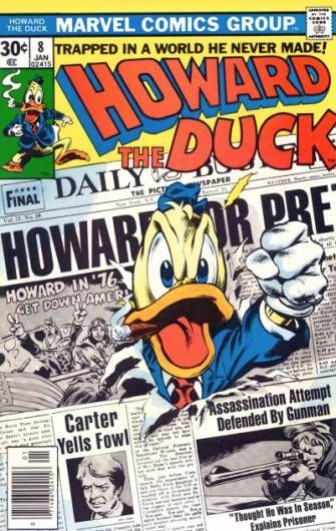 * Howard The Duck, Steve Gerber and Various, A Marvel Comic Book Series
* Howard The Duck, Steve Gerber and Various, A Marvel Comic Book Series
Steve Gerber's disheveled masterpiece of a mainstream comic book series came out at time in the country's and its industry's history that its singular status was magnified almost 1000 times. Thus it was -- maybe still is -- given credit for inventing things in comics that it only did very well.
HTD triggered the most heartfelt reaction from you guys. Critic Rob Clough: "Gerber may be
the emblematic 70s writer: acidic and bleak in outlook, he was of the generation directly influenced by superhero comics. Even though his ambitions seemed larger than that particular stage, he always seemed limited to working in genre comics, even as he twisted and warped the readers' conception of what that meant… Being paired with a ridiculously versatile and quirky craftsman as Gene Colan made these books especially memorable."
Will Pfeifer: "It's tough to top
Howard the Duck for sheer 1970s-ness. Not only did Gerber and company touch on many of the trends of the era, but the whole comic had a certain downtrodden scruffiness that somehow still feels like that decade -- specifically the Ford/Carter years."
*****
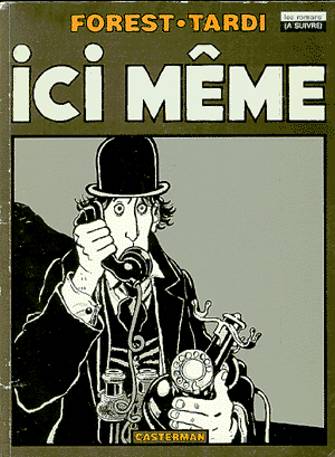 * Ici Meme, Jean-Claude Forest and Jacques Tardi, A Serialized Story Then Collected Into Album Form From Casterman
* Ici Meme, Jean-Claude Forest and Jacques Tardi, A Serialized Story Then Collected Into Album Form From Casterman
This grand effort by Jacques Tardi and Jean-Claude Forest may seem like an extravagant oddity now, but it gets credit from some for igniting a wave of alternative voices in a French-language comics industry whose mainstream had the added appeal of actually making its creators popular and wealthy successes. Even if you don't like the tune -- and while it's a song I could personally listen to every day, I know many people couldn't -- at the time I have to imagine that many comics readers weren't even aware that the medium could play some of these notes.
*****
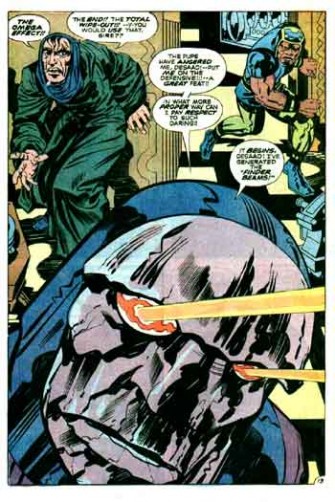 * Jack Kirby's Fourth World Saga, A Cycle Of Various Comic Book Series With Overriding Themes And Plotlines From DC Comics
* Jack Kirby's Fourth World Saga, A Cycle Of Various Comic Book Series With Overriding Themes And Plotlines From DC Comics
Still the grandest of all the post-Marvel superhero comics, despite some beautiful efforts in the last 30 years by some of the smartest and most talented creators out there. Writers and artists still make Fourth World stories, too, latching onto the bombast and the (mostly) killer character concepts and designs. If you read the original comics now, what comes through much more than the sum total of Kirby's masterful and shameless mythological appropriations is a sly, somber, and thorough dissection of the superhero concept. It is the only superhero book ever that fundamentally distrusts fight scenes, that offers up multiple characters whose values comes from avoiding fights. As one may suspect, it's a cycle of comic books about war, particularly the winning and the losing of them.
*****
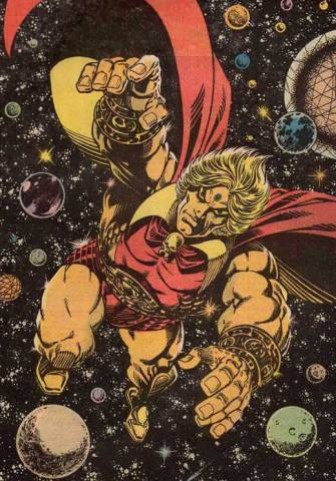 * Jim Starlin's Warlock Comics, Strange Tales and Warlock, Issues Of Comic Book Series From Marvel
* Jim Starlin's Warlock Comics, Strange Tales and Warlock, Issues Of Comic Book Series From Marvel
"I'm sure you've already gotten this a dozen or more times, but Starlin's Warlock stuff is more 70s than Hotel California, even." -- Sandy Yeah, that about sums it up. Jim Starlin's superhero space odyssey practically sweats its decade of origin from every pore; it's like being stuck in a room with a Black Oak Arkansas album playing as you sit in a barcalounger, surrounded walls, floor and ceiling by 350 fuzzy carnival posters of Shaft shaking hands with Richard Nixon. I'm pretty sure that if you ate pop rocks and chugged a coke your skin turned the exact shade of green as Gamora's and that if you wore your mood ring for 180 days in a row Pip The Troll's face appeared on it and asked you for a beer.
In a way, Starlin's work was a continuation of the pop culture conscious work of Marvel's previous decade, only this time the culture being folded into the punching and hitting and displays of power was broken, weird and untrustworthy. You can spend hours puzzling through the comics playing "Was this Jim Starlin's version of that?" and enjoying yourself the entire time.
*****
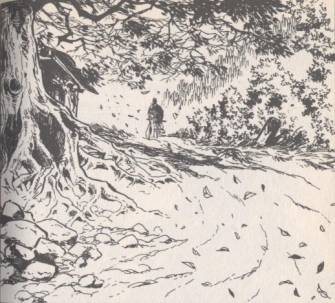 * Lone Wolf And Cub, Kazuo Koike and Goseki Kojima, A Serialized Story Also Collected Into Serial Book Form From Futabasha
* Lone Wolf And Cub, Kazuo Koike and Goseki Kojima, A Serialized Story Also Collected Into Serial Book Form From Futabasha
Super-rewarding adventure comics with a killer hook and an accessible yet uniquely different way of depicting power action on the comics page. It influenced everyone important to that area of comics from the early 1980s-on. It was also one of the first comics were its cross-media efforts were as important in the discovery of its value for many fans as the original comics were. As Bart Beaty reminded me recently,
Lone Wolf And Cub also boasts one of the medium's best series endings.
*****
 * Slow Death #1-10, Various, Issues Of A Comic Book Series
* Slow Death #1-10, Various, Issues Of A Comic Book Series
I'm not sure I'm the person to make the case for the significance of
Slow Death, but when I think of the change in underground comix in the 1970s and the greater reliance on genre transformation and taboo approaches to subject matter, it's the series I always think of. I'm sure I'm not the first one to point out the irony of the name given where undergrounds went this decade. There are some astounding artists in here.
*****
 * Superman Vs. Muhammad Ali, Dennis O'Neil and Neal Adams, An Over-Sized One-Shot Comic Book Story
* Superman Vs. Muhammad Ali, Dennis O'Neil and Neal Adams, An Over-Sized One-Shot Comic Book Story
As mentioned in the opening, the 1970s were a decade of format tweaks and novelty comics, a mad scramble to replace the audiences shedding the traditional comic book and weekly spinner rack visit. The historical importance of these strategies can't be overstated. The big companies' commitment to the Direct Market was inspired by years of frustration doing anything and everything but making such a commitment. Marvel was apparently saved outright by the Stars Wars license. And so on. The vast majority of the efforts inside those books, however, ran the gamut from grimly competent to weakly discouraging.
This over-sized book sporting Neal Adams art, greeted with some contempt at the time of its publication, may in retrospect be the best book of its class. Not just the cover, not just the concept, a surprising amount of this one's actual narrative sticks in the memory: Superman's hilarious umbrage out of Ali suggesting he's earth's champion, the training sequence between the two heroes under a red-sun light in a kind of folded-time training space, the capture of Muhammad Ali's boastful rhyme-making in panel-to-panel progressions, that shot of Superman being led off on a stretcher, the Man of Steel using Ali's rope-a-dope to fight an alien armada… it's an unabashed kids' comic, operating out of a little kid's "What If?" logic, and because of it the comic serves both icons well. These days, with a corporate license to protect and the fragile egos of tens of thousands way-too-invested fans to assuage, Ali would likely take it on the chops at least once just to show the rest of the world who's boss.
*****
 * The Fabulous Furry Freak Brothers #1-5, Gilbert Shelton, Issues Of A Comic Book Series From Rip-Off Press
* The Fabulous Furry Freak Brothers #1-5, Gilbert Shelton, Issues Of A Comic Book Series From Rip-Off Press
For most of the country, the 1960s didn't hit until a few years into the 1970s, and even then what was going on in places like San Francisco and New York in sharply contrasting, staggered waves of social development were fairly grandfathered in as a soft veneer of broad counter-cultural expression. The Freak Brothers survived their own adventures and the disintegration of the Underground Comix market with equal aplomb.
Or, as XXXX xXXX put it. "The counterculture/mainstream issue again, but this time from the counterculture side. Q. What do we do now that the 60s are over? A. Get high and read comic books!" Indeed.
*****
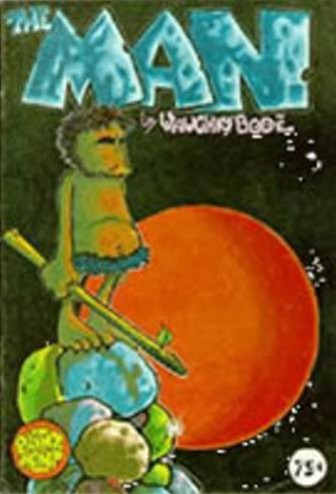 * The Man, Vaughn Bode, A Stand-Alone Comic From Print Mint
* The Man, Vaughn Bode, A Stand-Alone Comic From Print Mint
I wanted to include Vaughn Bode somewhere on this list, whose entire style may actually trump that of every single other cartoonist when it comes to a look that screams 1970s! 1970s! 1970s! The all-too-infrequent critic Matt Seneca suggested this stand-alone story, and that's fine with me.
*****
 * The Smithsonian Collection of Newspaper Comics, Edited By Bill Blackbeard And Martin Williams, A Stand-Alone Book Collection
* The Smithsonian Collection of Newspaper Comics, Edited By Bill Blackbeard And Martin Williams, A Stand-Alone Book Collection
Definitely the greatest and most influential reprint work in comics history -- Jules Feiffer's
The Great Comic-Book Heroes comes in a distant second although that's really all about the essay -- the Smithsonian book reunited tens of thousands of readers with great work they had either never seen before or had viewed only in terms of second- or third-generation copies being squeezed out on the current comics page. It was for comics as if in film TV had come along and had somehow never shown an old movie until doing so all at once via a dedicated channel that fired up in 1978. The table of contents is basically the classic comics reprints section of your full-service major bookstore, and that's not an accident.
*****
 * Tomb Of Dracula, Marv Wolfman and Gene Colan, A Comic Book Series From Marvel Comics
* Tomb Of Dracula, Marv Wolfman and Gene Colan, A Comic Book Series From Marvel Comics
The most entertaining of the the horror-tinged adventure comics folks put out in the 1970s despite being the heaviest downer of a story ever put on a spinner rack. It gets the nod over the well-crafted
Swamp Thing because I could remember a couple dozen
Tomb moments and not a single story from the swamp monster series. As suggested, Tomb of Dracula captured not just a few classic horror archetypes in '70s clothing, not only added a few restless and vocationally-challenged opponents to the mix, it somehow captured the bleak outlook of a generation coming of age under the threat of a massive nuclear exchange as life's final chapter.
*****
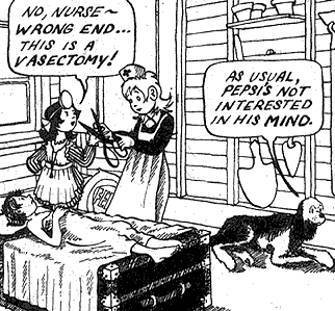 * Trots and Bonnie, Shary Flenniken, A Strip Appearing In National Lampoon Magazine
* Trots and Bonnie, Shary Flenniken, A Strip Appearing In National Lampoon Magazine
Great comics in weird places was a hallmark of the 1970s, as the industry's decay was in evidence even more than it is now, and the massively uneven National Lampoon's hosting of Trots and Bonnie feature made for probably the oddest marriage of great comics work to publication out there that decade. Idiosyncratic, fearless and attractive, it may be the same of our current industry that no one's done a super-fancy big reprinting of one of the few works that offers nearly every reader out there some element of discovery.
*****
 * X-Men #94-128, Chris Claremont and Dave Cockrum And John Byrne, Issues Of A Marvel Comic Book Series
* X-Men #94-128, Chris Claremont and Dave Cockrum And John Byrne, Issues Of A Marvel Comic Book Series
This was the first hit in comics fandom (its sales success until the mid-1980s is debatable) after the nadir of 1970s newsstand sales troubles and its concurrent adherence to old ways of publishing nearly brought to an end the mainstream comic book as we know it. Just being the first hit of modern superhero comics fandom might be enough to recommend it, as would being the most successful re-launch of an old concept with new characters.
X-Men crystallized a lot of what was entertaining about 1970s superhero comics into portable formula: the plunge into outright soap opera, the slow-burning subplots where it didn't matter if they were resolved or not, the mysterious characters whose backstory was doled out
Lost-style in inconceivably tiny, logic-defying increments, the way that the superhero's mission was recast for all time as one of noble struggle as opposed to good winning the day over evil. It also introduced us to the soon-to-upstage-everyone Wolverine, as inexplicable a character to comics as the Fonz was to television sitcoms. Danny DeVito's star-turn on
Taxi a possible exception, never have more young people enjoyed someone with that much back hair.
*****
*****
A few of my own that I left out after further consideration:
* Reg Smythe's
Andy Capp ran years before and years after but was inexplicably popular during the 1970s, to the point that an American television network was for a time considering a recurring animated short feature to run on their evening news. In the end, it didn't seem to represent anything about the time but that people in that moment in time seemed to love drunk mean people.
* counter to its reputation,
Peanuts had a glorious 1970s, bold and confident, and was deservedly the world's most popular newspaper strip. Yet its 1960s were slightly better and significant parts of other decades were just as good. The best way I can put it is that
Peanuts transcended the 1970s.
* I thought about finding an editorial cartoonist that really nailed the Nixon years, but doing so would have violated my own rule that a run of cartoons had to be good enough that it made an impression before I asked myself the library question. I would have started with Pat Oliphant.
* While I'm pretty certain I'm leaving those three off the list, I'm also struggling with the Green Arrow/Green Lantern "realism" stuff, competing shojo manga series (I heard back from absolutely no one on manga), and
Les Frustres, all of which I'll either add to the archived draft or explain in detail why I didn't.
*****
*****
A lot of good cases were made for various comic books from you guys that in the end I didn't use.
* Joey Manley suggested the Death Of Gwen Stacy issue of
Amazing Spider-Man as something prefigured the "Women In Refrigerators" trend. I had a hard time discounting this one because it was a pretty good comic book story -- Spider-Man lets Green Goblin die -- in a pretty good run of comic book stories (there's more than one comics critic out there that thinks the original clone saga that this issue made possible is among the best superhero comics of all time). I hate to say it, I've always thought the reaction of fans to Stacy's death was a fan's reaction rather than a reader's reaction; she just wasn't that memorable or interesting a character, although the visual was superb. I think a lot of fans deep down would admit that as readers they felt more mid-story when Captain Stacy died than when Gwen did, although maybe not until they stopped being mad at being asked. Manley also suggested more of the black and white newsstand magazines, just kind of that whole group of comics generally.
* Kim Munson suggested
Star Wars #1 and the series that followed. That's an important industry milestone but I can't muster any argument for the stories themselves, although I'm sure someone out there loves them to death and thinks them profound.
* Steven Solomon pointed out that the heady stew of 1970s superhero comics were exposed as being of their time by the Hernandez Brothers, whom he says " cracked open the way that we all accepted the superhero genre so completely that in Gerber's words, our minds were approved by The Comics Code."
* Alistair Robb wrote that as a Brit
Mighty World Of Marvel was right up there with
2000 AD in terms of defining that decade from his point of view.
* Gabe Carras suggested the Secret Empire/Nomad stories in
Captain Americaby Steve Englehart and Sal Buscema and the Silver St. Cloud stories in
Batman (or another of the Batman comics, I can't recall) by Englehart, Rogers and Austin. Those are both entertaining superhero storylines, but they're not transcendent or noteworthy in any way to me except being better than most of what was out there.
Those
Captain America stories have this interesting thing going where the troubles of the world are subsumed into standard superhero tropes "Oh, no! Henry Kissinger is a secret super-villain! Quick! What does this mean to me and my costume-wearing ways!" And that's been done a lot since and is kind of smart besides in that it keeps the story on message. I hate to say it, but the work doesn't really speak to me past that. Although, you know, big Roscoe fan.
* John Vest suggested
Star*Reach, as did a number of other folks. I understand the title's importance and it was certainly of its time, but it's hard for me to figure out anything in there that kind of breaks out. I know
Star*Reach; I can't
feel Star*Reach.
* Kenny Penman suggest the work with which I'm least familiar in the whole bunch, although I pulled it for this article.
Marvel Premiere 9-14,
Dr. Strange 1-5 (or 1-14).
"This Englehart run again takes a relatively minor character and takes him away from the way he was being used in things like Defenders and returns him to the worlds within worlds of the Ditko comics and adds a little real magic along the way. These comics got me back into comics as an 18 year old (was actually issue 12 by which time Colan was doing the art) as they seemed to open up a philosophical debates that were very pertinent to the times and seemed like nothing that had gone before. I think you could fairly argue that these comics had a huge influence on the material that would later be produced by UK writers such as Alan Moore and Grant Morrison."
I'm not that big a fan, although they're solid comics.
* Jeff Matthews says that the Archie Goodwin/Walt Simonson effort
Manhunter "took sequential art to a different level." I'm not sure I'd agree, although I like the way it folded over martial arts movies into comic books, a 1970s contribution to that genre if there ever was one.
* Bob Greenberger suggested
Conan the Barbarian #1-24 "Watching Barry's art grow in style and sophistication while Roy grew more comfortable with Robert E. Howard's character and gave us the first new genre in comics in years." I think those comics have a greater reputation than they deserve because they were on such a lonely island, surrounded by superheroes. The work itself has its imaginative flashes, but seems to me more rough than inspirational.
* Grant Goggans suggested
Battle Picture Weekly. He's probably right.
* Jay Willson suggested a number of superhero comics and other mainstream comics efforts that I thought were good but not necessarily emblematic: the Daughter of the Demon run in
Batman, the Spider-Man and Superman team-ups, Wally Wood's
JSA work,
Comic Book,
Deadly Hands Of Kung Fu,
Killraven, and Englehart's
Avengers/
Defenders saga. I think these are all of the time, and if the list were expanded many of these would make it. The
Avengers/
Defenders crossover has certain ramifications for the way comics are done now, although as a little-boy collector at the time the overwhelming experience my comics-reading acquaintances and I had about those book is panic at being able to find them in the spotty distribution channels of the time.
* Matt Seneca suggested
Chandler: Red Tide. I think if I expanded the list so that it room for interesting failures, this one might find companionship with some of the comics already on the list.
* the comics writer Joe Casey came up with an interesting one:
Avengers #105-150, Steve Englehart, Bob Brown, Sal Buscema, Don Heck, George Tuska, George Perez, "Here's what Englehart in particular did: He set a template for superhero team book storytelling that's still be followed to this day. It was decidedly different than the relentless, pile-it-on storytelling that Kirby mastered in the 60's. The template is as follows: start small, slowly build through various action plots and multiple character subplots that lead to a grand finale, then start all over again small and build it all up again. Englehart did it at least three times during his run, and he did it first."
* Kevin Church suggested
Omega The Unknown, which is very '70s although it's an incomplete work to my mind and I think this allows people to maybe read more into it than actually would have been there had it been finished. Big Numbers works like that, too.
Thanks to all that participated! No fair complaining if you didn't participate, but I can't imagine that will stop you. I will mull over this piece for a week or so before sticking a final version into the archives.
*****
*****
*****
posted 2:30 pm PST |
Permalink
Daily Blog Archives
November 2019
October 2019
September 2019
August 2019
July 2019
Full Archives


